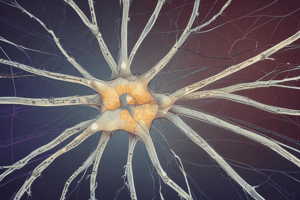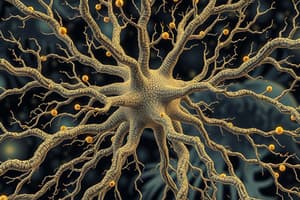Podcast
Questions and Answers
What is another name for the Neural Cell Body?
What is another name for the Neural Cell Body?
- Dendrite
- Axon
- Soma (correct)
- Perikaryon
What is the term for the cytoplasm that surrounds the nucleus of a neuron?
What is the term for the cytoplasm that surrounds the nucleus of a neuron?
Perikaryon
What are Neurofilaments?
What are Neurofilaments?
Intermediate filaments of neuron cytoskeleton
What do Neurotubules resemble?
What do Neurotubules resemble?
What are Neurofibrils?
What are Neurofibrils?
What are Dendrites specialized to do?
What are Dendrites specialized to do?
What is an Axon?
What is an Axon?
What is Axoplasm?
What is Axoplasm?
What is Axolemma?
What is Axolemma?
What is the Initial Segment of an axon?
What is the Initial Segment of an axon?
What is the Axon hillock?
What is the Axon hillock?
What are Collaterals?
What are Collaterals?
What are Telodendria?
What are Telodendria?
What are Axon Terminals?
What are Axon Terminals?
What is a Synapse?
What is a Synapse?
What are Neurotransmitters?
What are Neurotransmitters?
What is a Neuromuscular Junction?
What is a Neuromuscular Junction?
What is a Neuroglandular Junction?
What is a Neuroglandular Junction?
What is the Presynaptic Membrane?
What is the Presynaptic Membrane?
What is the Postsynaptic Membrane?
What is the Postsynaptic Membrane?
What is Axoplasmic Transport?
What is Axoplasmic Transport?
_____ neurons have multiple dendrites but no axon.
_____ neurons have multiple dendrites but no axon.
What do Bipolar Neurons have?
What do Bipolar Neurons have?
What characterizes a Unipolar Neuron?
What characterizes a Unipolar Neuron?
What are Multipolar Neurons?
What are Multipolar Neurons?
What are Sensory Neurons also known as?
What are Sensory Neurons also known as?
What is a Ganglion?
What is a Ganglion?
The axons of sensory neurons are called _________ and extend between a sensory receptor and the spinal cord or brain.
The axons of sensory neurons are called _________ and extend between a sensory receptor and the spinal cord or brain.
What do Somatic Sensory Neurons do?
What do Somatic Sensory Neurons do?
What do Visceral Sensory Neurons monitor?
What do Visceral Sensory Neurons monitor?
What are Interoceptors?
What are Interoceptors?
What do Exteroceptors provide?
What do Exteroceptors provide?
What are Proprioceptors?
What are Proprioceptors?
What do Motor Neurons do?
What do Motor Neurons do?
What are Efferent Fibers?
What are Efferent Fibers?
___________ innervate skeletal muscle to produce conscious, voluntary movements.
___________ innervate skeletal muscle to produce conscious, voluntary movements.
What do Visceral Motor Neurons innervate?
What do Visceral Motor Neurons innervate?
Where are Interneurons located?
Where are Interneurons located?
Flashcards are hidden until you start studying
Study Notes
Neurons and Their Structures
- Neural cell body (soma) houses a prominent nucleus and nucleolus.
- Perikaryon refers to the cytoplasm surrounding the nucleus in a neuron.
- Neurofilaments are intermediate filaments that make up the neuron cytoskeleton.
- Neurotubules are similar to microtubules and are present in the perikaryon.
- Neurofibrils consist of bundles of neurofilaments that support dendrites and axons.
Types of Neuron Extensions
- Dendrites are branch-like structures responsible for receiving information.
- Axons are threadlike extensions that transmit nerve impulses away from the soma.
- Axoplasm is the cytoplasm within an axon, while the axolemma is its specialized plasma membrane.
- The initial segment is the base of the axon, and the axon hillock is the cone-shaped area where the axon connects to the cell body.
Axon Termination and Communication
- Collaterals are branches that may emerge along an axon.
- Telodendria are terminal branches at the axon's end, leading to axon terminals.
- Axon terminals house synaptic vesicles that contain neurotransmitters, facilitating communication across synapses.
Synapses and Neurotransmitters
- Synapse is a specialized junction where a neuron communicates with another cell.
- Neurotransmitters are chemical messengers that cross the synaptic gap and influence either the sending or receiving neuron.
- Neuromuscular junction is where a motor neuron meets a skeletal muscle cell, while neuroglandular junction refers to a synapse between a neuron and a gland.
Membrane Structures
- Presynaptic membrane is the site of neurotransmitter release, while the postsynaptic membrane is part of the receiving cell's plasma membrane involved in the synapse.
Axoplasmic Transport
- Axoplasmic transport refers to the movement of materials between the neuron cell body and synaptic terminals, functioning bidirectionally.
Types of Neurons
- Anaxonic neurons lack axons but have multiple dendrites, primarily communicating through dendrites.
- Bipolar neurons consist of one axon and one dendrite, with the cell body situated between them; they are rare and found in special senses.
- Unipolar neurons have a continuous dendrite and axon structure, with the cell body situated off to one side.
- Multipolar neurons have one axon and multiple dendrites; they are the most common neurons in the CNS, including motor neurons for skeletal muscle.
Sensory Neurons and Functions
- Sensory (afferent) neurons transmit information from sensory receptors to the CNS.
- Ganglia are collections of neuron cell bodies located in the PNS.
- Afferent fibers are axons of sensory neurons leading to the CNS.
Types of Sensory Neurons
- Somatic sensory neurons monitor the external environment via sensory receptors in the skin and muscles.
- Visceral sensory neurons observe internal conditions within organs.
- Interoceptors detect sensations such as distension and pain from the internal systems.
- Exteroceptors provide information on external stimuli like touch and pressure.
- Proprioceptors are sensory receptors in muscles and joints that inform on body position and movement.
Motor Neurons and Their Pathways
- Motor (efferent) neurons carry impulses from the brain and spinal cord to muscles and glands, forming the efferent division of the PNS.
- Efferent fibers are those axons that travel away from the CNS.
- Somatic motor neurons stimulate voluntary movements in skeletal muscles.
- Visceral motor neurons innervate smooth muscle, cardiac muscle, glands, and adipose tissue throughout the body.
Interneurons
- Interneurons act as connectors between sensory and motor neurons, facilitating communication within the CNS.
Studying That Suits You
Use AI to generate personalized quizzes and flashcards to suit your learning preferences.




